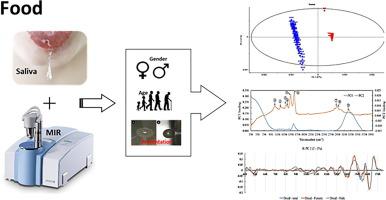Spectrochimica Acta Part A: Molecular and Biomolecular Spectroscopy ( IF 4.3 ) Pub Date : 2021-02-09 , DOI: 10.1016/j.saa.2021.119569 Dongdong Ni , Heather E Smyth , Michael J Gidley , Daniel Cozzolino

|
The aims of this study were to compare two sample presentations (dry and whole) as well as the effects of both gender and age on the mid infrared (MIR) fingerprint spectra of human saliva. Unstimulated saliva was collected from 52 Female (31 subjects, aged 40.9 ± 14.6 year) and Male (21 subjects, aged 34 ± 11.8 year) participants, stored frozen, and subsequently thawed and analysed by MIR spectroscopy as whole and dried saliva, respectively. Data were analysed by means of principal components analysis (PCA) and partial least squares (PLS) to interpret and compare the effects of presentation (dry vs whole), age and gender on the MIR spectra of saliva. Interpretation of the MIR spectra of both whole and dried samples revealed specific characteristic and different spectral signals when gender and age were compared in the amide I and amide II of proteins (e.g. albumin) and DNA. While whole saliva analysis might be more convenient for rapid test, dried saliva spectra were more consistent across replicates, demonstrating greater ability to distinguish individual differences. The interpretation of the PCA and PLS loadings of both whole and dried saliva samples allowed identification of specific MIR regions associated with age and gender of participants between 1000 cm−1 and 1800 cm−1. In particular, the MIR regions associated with the absorption of polysaccharides, glycosylated proteins, and nucleic acid phosphate groups present in saliva were the most dominant. This paper demonstrates that MIR spectroscopy can be used to measure saliva samples and to interpret individual differences in participants due to age in either dry or whole samples. No clear trends were observed in the MIR spectra of the samples associated with gender when all samples were analysed together. However, PLS regression models were able to predict gender in a subset of samples having similar age. The approach described in this study shows promise for potentially using saliva as a tool in food studies (e.g. saliva interactions between food and consumers).
中文翻译:

走向个性化的唾液光谱指纹图:干燥和整个唾液样品的中红外光谱比较
这项研究的目的是比较两种样品的表现形式(干态和整体态),以及性别和年龄对人唾液中红外(MIR)指纹图谱的影响。从52名女性(31名受试者,年龄为40.9±14.6岁)和男性(21名受试者,年龄为34±11.8岁)参与者中收集未刺激的唾液,将其冷冻保存,然后解冻,并通过MIR光谱法分别对整个唾液和干唾液进行分析。数据通过主成分分析(PCA)和偏最小二乘(PLS)进行分析,以解释和比较外观(干对整体),年龄和性别对唾液MIR谱的影响。当比较蛋白质(例如白蛋白)和DNA的酰胺I和酰胺II中的性别和年龄时,对整个样品和干燥样品的MIR光谱的解释都显示出特定的特征和不同的光谱信号。虽然整个唾液分析可能更便于快速测试,但干燥的唾液光谱在重复样本中更为一致,这表明了区分个体差异的能力更高。完整和干燥唾液样品中PCA和PLS含量的解释可以识别与参与者年龄和性别之间相关的特定MIR区域(1000厘米之间)-1和1800 cm -1。特别地,与唾液中存在的多糖,糖基化蛋白和核酸磷酸基团的吸收有关的MIR区域是最主要的。本文证明,MIR光谱学可用于测量唾液样本,并解释由于干样本或整样本中年龄引起的参与者个体差异。当所有样本一起分析时,在与性别相关的样本的MIR光谱中没有观察到明显的趋势。但是,PLS回归模型能够预测年龄相似的样本子集中的性别。这项研究中描述的方法显示了有望将唾液用作食品研究的工具(例如,食品和消费者之间的唾液相互作用)。











































 京公网安备 11010802027423号
京公网安备 11010802027423号